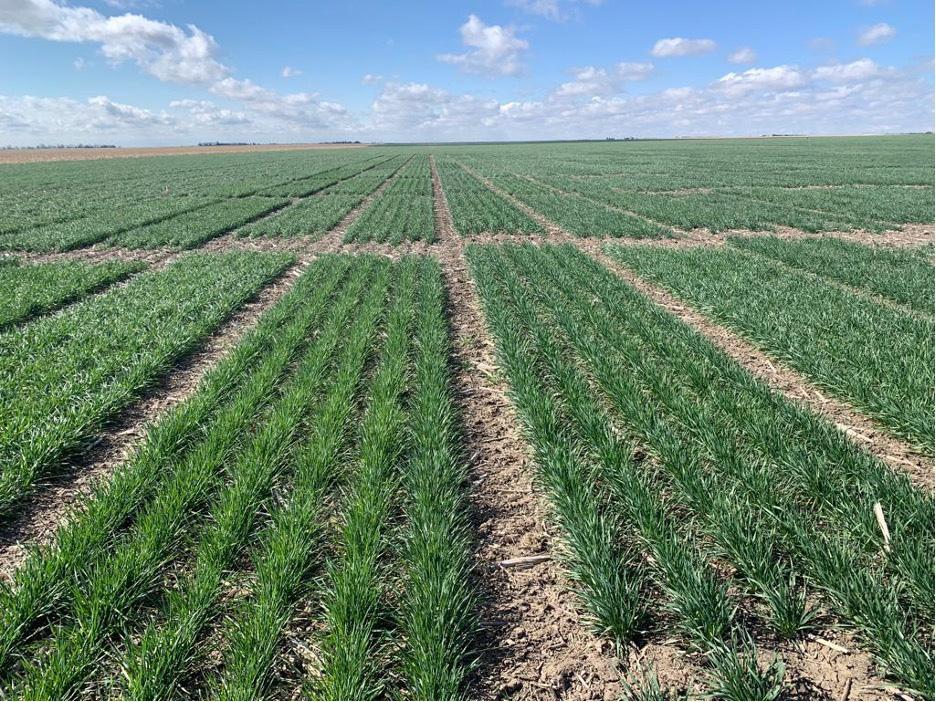
Uncommon Wheat Disease in the Nebraska Panhandle in 2023
Over 50% of wheat grown in Nebraska is produced in the Panhandle. This region is typically characterized by low precipitation; however, 2023 saw frequent rains before and during flowering.
The 2024 winter wheat crop is out of dormancy in Nebraska (Figure 1) and the recent USDA NASS report estimates that 68% is in good-excellent condition. Good fall seeding conditions led to excellent stand establishment in the Nebraska Panhandle. However, Fusarium head blight (FHB, scab) — a disease rare to this semi-arid region — was present in the 2023 crop (Figure 2), and its effects continues into 2024.

FHB is a fungal disease that is common in humid wheat-growing regions with frequent rainfall. It is predominantly caused by the fungus Fusarium graminearum that survives on residue from previous cereal crops (corn, wheat, barley, rye, triticale, millet). Because rains rarely occur in plentiful amounts in the Panhandle before and during wheat flowering, growers are unaccustomed to FHB, which prematurely bleaches wheat heads.
Frequent rainfall and moderate to warm temperatures before and during flowering favor the release of spores of the fungus from fruiting structures that survive on cereal residue. The spores are dispersed by wind currents and splashing rain, and land on the wheat heads. If the wheat heads are flowering, the florets provide a suitable environment for infection, leading to partial or complete bleaching of heads (Figures 3 and 4).
Infected wheat kernels develop poorly, become shriveled, and can show an orange-pinkish hue that indicates the presence of Fusarium spores. These kernels are known as Fusarium-damaged kernels (FDK), scabby kernels, or tombstones (Figure 5).
The FHB fungus produces mycotoxins, which contaminate grain. The most common mycotoxin is deoxynivalenol (DON, vomitoxin), which is harmful to human and animal health. DON levels are closely monitored by elevators and end users of wheat in frequently affected areas. Prevalence of mycotoxins in wheat grown in the Panhandle in 2023 is not known because it is rarely tested by regional elevators and end users.
The southern Panhandle of Nebraska was a location of heavy infection in 2023, where growers experienced lower yields and lower test weight in many of their fields. Few varieties grown in the region have moderate resistance to scab, so fungicide applications are still recommended for varieties under conditions favorable for FHB. Refer to the UNL Fall Seed guides or consult with seed suppliers regarding variety selection.
Root rot, crown rot and seedling blight can occur if scabby seed is used to plant the next wheat crop.
Unfortunately, the scab that occurred in 2023 is also impacting wheat this year, and this highlights the importance of using high quality seed and seed treatment. Fusarium-damaged kernels are infected by Fusarium, which may or may not be obvious visually. If scabby seed is planted, root rot, crown rot and seedling blight can occur in the wheat crop due to infection by seedborne Fusarium. This situation has been observed this year in a field planted to bin-run, saved seed from the 2023 growing season.
The symptoms of root and crown rot are subtle and sometimes hard to identify in the fall after germination but become more visible after green-up. This year, root and crown rot has presented as patchy spots in the field that initially look like winterkill or poor stand (Figure 6). Upon closer examination, the roots and crowns have a brownish/dark color and the root system is sparse compared to healthy roots (Figure 7). The pattern of brown leaves shown in Figure 6 is not consistent with that of winterkill, because winterkill damage will be seen mostly on the tips of the leaves on the plant.
When infection is present as root or crown rot, there are no chemical control options because fungicides will not be effective. Less affected plants may grow out of some of the symptomology but should be monitored closely. The best ways to control future infection is through using high quality, inspected and fungicide-treated seed; being mindful of the impact of cultural practices and crop rotations, since corn and millet are hosts of the FHB fungus.
Managing FHB in 2024
The impact of FHB on this year’s crop can be mitigated by monitoring the weather and applying fungicide at early flowering if disease-favorable environmental conditions prevail — frequent rainfall before and during flowering.
Fungicides effective on FHB include Miravis Ace, Prosaro Pro, and Sphaerex. The timings and types of fungicides used for control of foliar diseases such as leaf or stripe rust have little efficacy on control of FHB, so a second application of fungicides may be required if both types of pathogens are present.
A useful tool to help you assess the risk of FHB in your area is the Fusarium Risk Tool. Click on the Central Great Plains Hard Winter Wheat map to see the level of FHB risk in your area (yellow, orange and red indicate low, medium and high risk, respectively).
If a high risk is indicated in your area and the wheat is nearing flowering, apply a fungicide at early flowering. Once symptoms (bleached heads) appear, it is too late to control FHB.
Online Master of Science in Agronomy
With a focus on industry applications and research, the online program is designed with maximum flexibility for today's working professionals.





